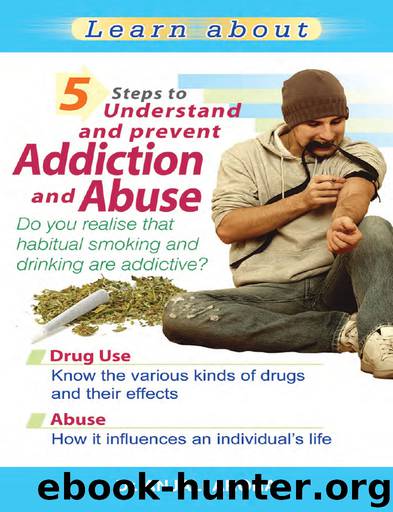5 Steps To Prevent Addictions & Abuse by Anjali Arora

Author:Anjali Arora
Language: eng
Format: epub
Publisher: Sterling Publishers Pvt Ltd
4. In the last year has a relative or friend, or a doctor or other health worker been concerned about your drinking or suggested you cut down?
Scoring the FAST questionnaire
Scoring is quick and can be completed with just a glance at the pattern of responses as follows:
Score questions 1, 2 and 3 as follows: Score question 4 as follows:
Never =0 ON= 0
Less than monthly = 1 Yes, on one occasion = 2
Monthly = 2 Yes, on more than one occasion = 4
Weekly = 3
Daily or almost daily = 4
Stage 1
The first stage only involves question 1.
If the response to question 1 is Never then the patient is not misusing alcohol.
If the response to question 1 is Weekly or Daily or almost daily then the patient is a hazardous, harmful or dependent drinker.
Over 50% of people will be classified using just this one question.
Only consider questions 2, 3 and 4, if the response to question 1 is less than monthly or monthly.
Stage 2
If the response to question 1 is Less than monthly or Monthly then each of the four questions is scored 0 to 4. These are then added together, resulting in a total score between 0 and 16. The person is misusing alcohol if the total score for all four questions is 3 or more.
Summary
Score questions 1 to 3: 0, 1, 2, 3, 4
Score question 4: 0, 2, 4
The minimum score is 0
The maximum score is 16
The score for hazardous drinking is 3 or more.
Health Development Agency, University of Wales, College of Medicine 2002.
Managing an Alcoholic
An Alcoholics Management is successful when the primary care physician remains the most trusted person in the individuals life. Treatment should be personalized and long term. Remember alcoholism is progressive. More the alcohol consumed, more is the tolerance developed by the body.
The importance is in:
Early intervention. Sooner the alcoholism is detected, better the chances of reversal.
Proper patient determination.
Personalized assessment and treatment.
Cognitive behavioural therapy. A person recognizing situations that triggers off alcohol consumption.
Continuous care. Treatment for alcoholism cannot be achieved in a short time. Continuous consultation and a regular support group participation, help in a permanent cure.
Prevention of Alcoholism
Adequate parental supervision has been found to be a deterrent in underage alcohol abuse. Alcohol, and other drug use, has been found to occur most often between 3 p.m. and 6 p.m., immediately after school or college and prior to parents’ arrival at home from work. Teen participation in extracurricular activities is an important preventive measure for the use of alcohol in this age group. Limiting the availability of alcohol and enforcing strict rules for drunk driving are important deterrents against alcohol abuse. Limited accessibility of alcohol, raising its cost and restricting its consumption are other helpful preventive measures.
Teenagers are three times more likely to develop drug and alcohol problems than adults. This is due to immature coping skills.
The brain continues to develop throughout teenage into young adulthood. Alcohol is a drug that works directly on the central nervous system. Drinking during this critical development period can lead
Download
This site does not store any files on its server. We only index and link to content provided by other sites. Please contact the content providers to delete copyright contents if any and email us, we'll remove relevant links or contents immediately.
Unwinding Anxiety by Judson Brewer(72058)
The Art of Coaching by Elena Aguilar(52249)
The Fast Metabolism Diet Cookbook by Haylie Pomroy(20930)
Rewire Your Anxious Brain by Catherine M. Pittman(18337)
Healthy Aging For Dummies by Brent Agin & Sharon Perkins RN(16935)
Talking to Strangers by Malcolm Gladwell(12916)
The Art of Thinking Clearly by Rolf Dobelli(9951)
Crazy Rich Asians by Kevin Kwan(8912)
Mindhunter: Inside the FBI's Elite Serial Crime Unit by John E. Douglas & Mark Olshaker(8751)
The Compound Effect by Darren Hardy(8544)
Periodization Training for Sports by Tudor Bompa(7947)
Becoming Supernatural by Dr. Joe Dispenza(7869)
Tools of Titans by Timothy Ferriss(7850)
Wonder by R. J. Palacio(7756)
Crystal Healing for Women by Mariah K. Lyons(7734)
Bodyweight Strength Training by Jay Cardiello(7686)
Therapeutic Modalities for Musculoskeletal Injuries, 4E by Craig R. Denegar & Ethan Saliba & Susan Saliba(7606)
Should I Stay or Should I Go? by Ramani Durvasula(7440)
Change Your Questions, Change Your Life by Marilee Adams(7405)
